Roof Maxx Review
Roof Maxx® Review
Chrystal asked me to call her. I shared a different method to protect her roof that is much cheaper than the Roof-Maxx method. At the end of the call she said, "I appreciate you!! THANK YOU!! You just saved us $15,000!! So happy I came across your page!!" Best, Chrystal
This column was inspired by emails and inquiries from some of my 31,000 subscribers who read my March 11, 2020 AsktheBuilder Newsletter.
This is a virtual review of a product and service sold by a USA company called Roof Maxx®. I say virtual because I’ve not used the product on my roof and even if I did, I don’t possess the scientific experience nor my own certified testing labs to tell you if the product does what the Roof Maxx® company claims that it does. I doubt you have that expertise either.
I can tell you that I wrote an authoritative book, Roofing Ripoff, about asphalt shingles that deteriorate sooner than they should. This short easy-to-read book contains what I know to be the root cause of this deterioration, and a simple low-cost one-time fix that you can do to make sure your asphalt shingles last 30, 40, and possibly 50 years.
CAVEAT: Any of the following information that is not taken from the Roof Maxx® website, literature, or videos invoking the Fair Use doctrine is my opinion. My opinions are based on years of hands-on roofing experience and input from scientists and roofing industry leaders that have shared their experience and knowledge with me.
What is Roof Maxx®?
This question can be answered looking at the text on the Roof Maxx® website current as of March 10, 2020:
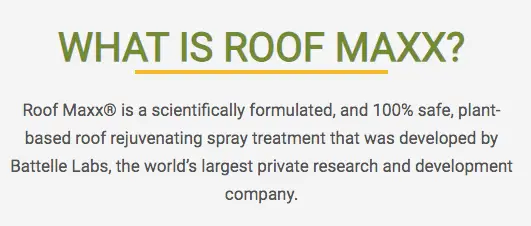
Copyright 2020 Roof Maxx®
What is the rejuvenating spray treatment?
Roof Maxx® installers spray on a soybean-based chemical that contains a soy methyl ester emulsion (SMEE). The spray may also contain some sort of cleaning agent because Roof Maxx® claims that the spray cleans algae off roofs as part of the application.
How Long Does the Treatment Last?
Roof Maxx® is only willing to offer a five-year warranty. Look closely at the warranty language as no doubt it’s prorated. The more important consideration is, how can you make a valid claim that the product has failed and your roof is in worse shape than just after the spray was applied?
How Much Does Roof Maxx® Cost?
The video on their website as of March 10, 2020, says that the cost of the treatment is approximately 20 percent of the cost of replacing your shingle roof with new shingles. In other words, it’s an expensive product to apply. The average cost could be around $2,000 - $2,400.
How Does Roof Maxx® Work?
The Roof Maxx® company states that the patented SMEE solution replaces lost oils in the shingles, restoring their flexibility and waterproofing capability. Here’s exactly what Roof Maxx® says about how their product works.
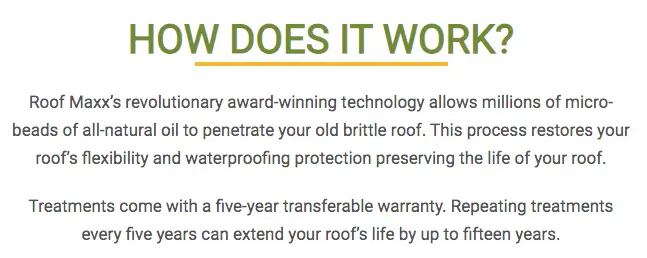
Copyright 2020 Roof Maxx
In the Roof Maxx® PBS Mini Documentary video on the Roof Maxx® website, the narrator says:
“When installed, roof shingles have essential oil in the asphalt that allows for daily expansion and contraction. And as they age, the oil begins to dry out causing the asphalt to become brittle and crack.”
Are My Asphalt Shingles Falling Apart Because They’re Losing Oil?
In my opinion, the primary reason your shingles are falling apart is because the asphalt used to make them is not as high quality as it could have been. While there could be some oil loss, any older roofer can tell you that asphalt shingles made in the 1960s and 1970s would last for decades.
If oil loss was the primary reason for failure, then all those shingles all those years ago would have exhibited brittleness or cracking in 7-10 years. The truth is they didn’t. I offer up proof of this in my Roofing Ripoff book.
I was fortunate to have a deep-throat source for my Roofing Ripoff expose’ book. This person grew up in the asphalt shingle manufacturing business. He was also a prominent and well-known leader within the asphalt roofing industry.
He reached out to me after reading a column of mine in the Washington Post where I lamented about my failed asphalt shingle roof. I shared in that column how the Asphalt Roofing Manufacturers Association rebuked my request for answers to probing questions about why asphalt shingles were failing all across the USA.
Asphalt roofing shingles are falling apart much faster than they used to because many of the manufacturers are pre-aging the asphalt used to make the shingles. They’re blowing too much air into the asphalt before it’s applied to the mat that makes the shingles. I cover this in great detail in my Roofing Ripoff book.
Some air is required to be blown into asphalt so it doesn’t liquify and flow off your roof on a hot summer day. But blowing too much air into the asphalt starts to make it brittle where it loses its ability to hold on tightly to the colored ceramic granules and retain its flexibility
This extra oxygen causes too many asphalt molecules to cross-link to one another and the resulting asphalt shingles are then prone to being brittle even before they’re applied to a roof. The proof of this lies in the fact that many new asphalt shingle roofs experience granule loss in the months after the roof is applied. The granule loss continues to happen until such time as the roof needs to be replaced.
The protective ceramic granules start to pop off because of the asphalt’s brittle surface, causing more asphalt to be exposed to the sun’s harmful ultraviolet (UV) light. About five percent of UV light contains active photons and these powerful particles blast apart asphalt molecules exposing them to additional oxidation. The additional oxidation causes the shingles to become even more brittle.
When you open most new packs of asphalt shingles, you probably assume they’re new. The issue is that while they are new, they start to perform as if they’ve already been on your roof for 15, 20, or 25 years.
Is it Possible for the Roof Maxx® Soybean Solution to Penetrate Through the Ceramic-Coated Solid-Rock Granules That Cover My Asphalt Shingles?
My college degree is in geology, the study of rocks. The granules on your asphalt shingles are made from rock and then a thin ceramic coating is applied.
A ceramic coating is actually a thin layer of glass. Common sense would dictate that it would be seemingly impossible for any solution to penetrate through glass into the rock and then escape through the underside of the glass-coated granule to eventually get to the asphalt under the colored granules.
The Roof Maxx® company sent me a document where they maintain it can penetrate through glass. Here’s what was said in the document:
“When Roof Maxx® is sprayed on an aging asphalt-shingle roof, the treatment penetrates through the granules and is absorbed into the asphalt layer.”
I suspect what’s actually happening is the soybean product is actually passing around the granules and being absorbed into the asphalt that way.
Is There Another Method to Slow Down the Deterioration of the Shingles?
Yes. There’s not only another way to achieve the goal that Roof Maxx® is striving for, but it’s also much much cheaper and you only have to do it one time, not every five years as the Roof Maxx® company suggests.
What is the Alternative Method?
All you need to do is place a wide piece of thin copper at the top of each plane of shingles on your roof. You can apply the copper to a new roof or an existing shingle roof that is not yet showing signs of advanced deterioration like curled edges and large spots where many granules are missing.
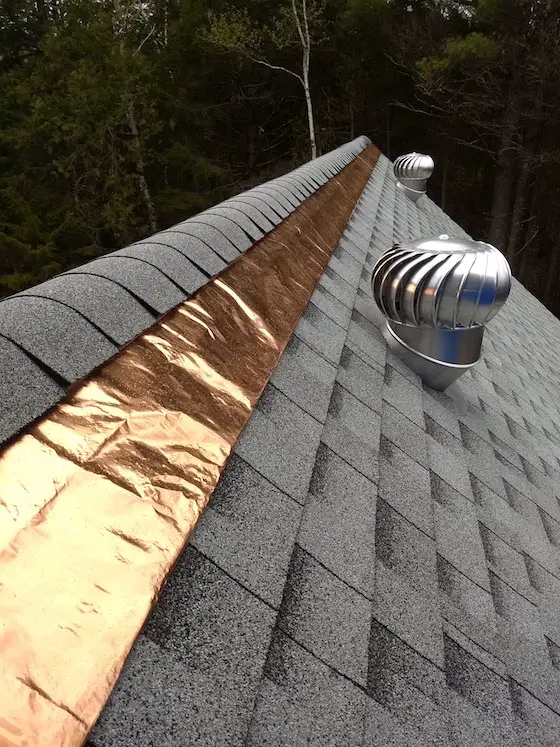
I was the first person in the world to identify that copper prevents the oxidation of asphalt molecules on asphalt shingles. See how easy it is to install this copper in a new-roof installation? CLICK the photo or TAP HERE to order the copper strips. After a few months exposure to the elements, the bright copper dulls down to a nut-brown color.
Each time it rains, a small amount of copper washes onto the shingles. Some of the copper ions attach to the asphalt molecules that have been broken by the UV sunlight. When the copper bonds to the asphalt it prevents the cross-linking of the asphalt molecules that happens under normal oxidation.
Remember, the more asphalt molecules that cross-link, the more brittle the shingles become. The copper chemical reaction slows this cross-linking allowing your shingles to age very slowly.
The advantage of the copper method is that it’s a one-time fix.
You put it on and forget about it. You’ll never have to do anything again as long as you own your home. When you consider that you might be saving yourself from having to get a new roof, the copper method is a reasonably priced fix. You can purchase enough copper for the average roof for less than $400.00 in 2020 dollars.
I was the first person in the world to discover this beneficial chemical reaction between copper and asphalt. It happened completely by chance one day as I walked out of a restaurant in Tilton, NH and saw the roof on the old Tilton, NH post office. That photo is in my Roofing Ripoff expose’ book.
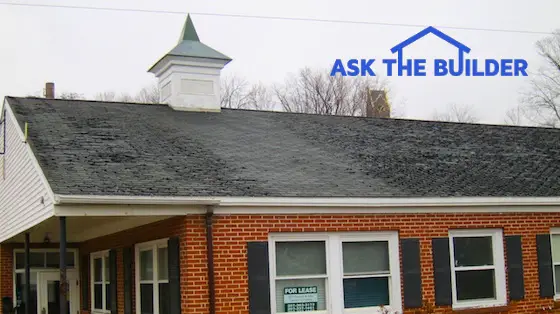
Look at how the 8-foot-wide strip of asphalt shingles look nearly perfect. This is the roof of the old Tilton,NH post office. The other shingles on either side have lost their granules and are curled as can be. The copper ions washing off the cupola roof STOP the oxidation of the asphalt. When asphalt oxidizes, the molecules cross link and become brittle. CLICK THE PHOTO NOW TO ORDER AFFORDABLE COPPER STRIPS THAT WILL SAVE YOUR ROOF.
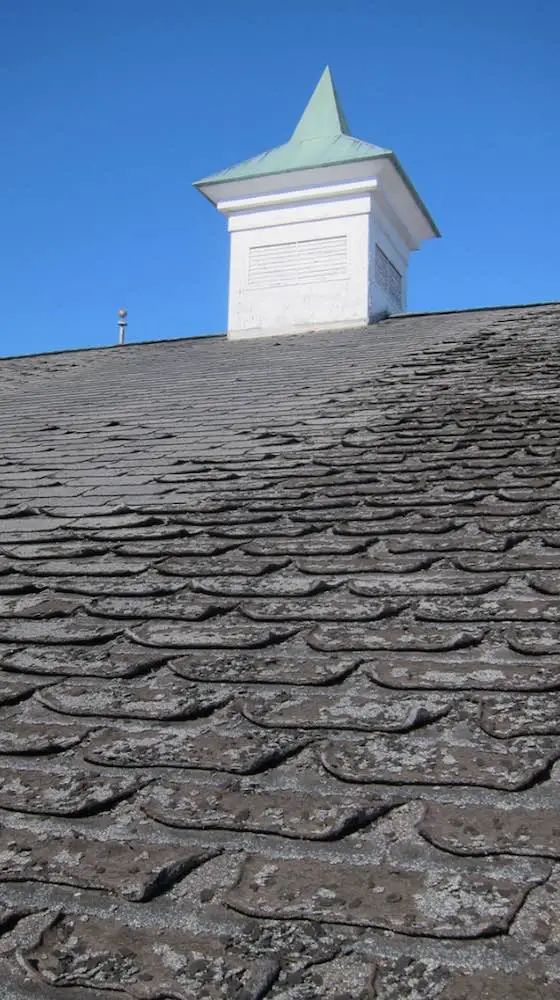
This photo tells you all you need to know about how copper slows down the oxidation of asphalt shingles. Look at how bad the shingles are that don't get copper ions washing over them.
Did the Roof Maxx® Company contact you to Review their Product?
Yes. On Friday, February 14, 2020, Bobby Wright, who represents Roof Maxx®, sent me a message via the Ask Tim page on my AsktheBuilder.com website. He wrote:
“I'm hoping to have a live conversation with you in regards to a new product called Roof Maxx. I'm even interested in performing a free demonstration for you to get your feedback. Please contact me at (614) XXX-XXXX to discuss. I am a follower of your work and appreciate all you do for the consumer world. It would be an honor to be associated with you.”
Bobby also attached a fancy full-color document produced by the Ohio State College of Food, Agricultural, and Environmental Sciences about SMEEs.
I responded within minutes asking him when he’d be coming to New Hampshire as I imagined he thought I still lived down the road in Cincinnati, Ohio. I then recommended to him that he read my Roofing Ripoff book because I felt that his company was not fully aware of the root cause of shingle failure. They maintain it’s caused by oil loss. My research and the information from my deep-throat source say it’s caused by blowing too much air into the asphalt.
I suggested that he purchase a copy of the book, read it, send it to the scientists at Battelle Labs who developed the Roof Maxx® soy product, and then get back with me with his comments.
I heard nothing back from Bobby and at 8:38 a.m. on March 9, 2020, I sent a follow-up email to continue our conversation. Bobby didn’t respond. I then called Bobby’s direct phone number at 3:43 p.m. on March 9th, 2020. I left a message on Bobby’s voicemail. I asked him what the scientists at Battelle Labs had to say and if there was any input or response from the Roof Maxx® CEO, Mike Feazel.
I called once more on the morning of March 10, 2020, at 9:56 a.m. At 4:16 p.m. on March 10, 2020, I received a lengthy email response from the Roof Maxx® CEO, Mike Feazel. The key points were that the Battelle Labs scientists don’t dispute my approach or claims as to the root cause of shingle failure and the proven performance of copper as a way to slow down the deterioration of asphalt shingles.
He further went on to say, “However, I think we can agree that we're both attempting to help property owners achieve the same goal; Protect their investment and save money while keeping debris out of landfills.”
Mike concluded that he has no desire to take on the asphalt shingle manufacturers head-on and that, “I simply want to give property owners an option that wasn't otherwise available until now.”
What Questions Should I Ask the Roof Maxx® Salesman that Comes to My Home?
Here’s a list of questions I would ask a salesman before I’d sign a contract with a Roof Maxx® dealer:
Have you read syndicated columnist Tim Carter’s Roofing Ripoff book where he discusses what he believes to be the real root cause of asphalt shingle failure and his alternative approach to using copper rather than your product?
A vast percentage of my roof is covered with ceramic granules that act as a sunscreen to prevent UV damage. I don’t see any exposed asphalt when I look closely at a shingle. Does the soybean oil emulsion penetrate these granules? If so, how is it possible for them to get through glass? If not, then how does the soybean oil get to the asphalt underneath these granules?
How do I know if the Roof Maxx® product is working? Please give precise information how to determine this.
What is the evidence that the Roof Maxx® product is not working? If I continue to see ceramic granule loss, is that a symptom that the Roof Maxx® spray coating is not doing its job?
Is the Roof Maxx® warranty prorated?
How can I prove that the Roof Maxx® product didn’t work so I can file a warranty claim?
What documentation must I provide to make a valid claim?
Tim, What’s Your Final Opinion of Roof Maxx®?
My opinion is that the Roof Maxx® soybean solution is backed by solid science. The Battelle Labs in Columbus, Ohio, have a deep and rich pedigree.
I feel the biggest drawback with Roof Maxx® is that you must re-apply the product every few years to try to keep your roof in good shape. Whereas if you install the affordable copper strips on your roof, you never have to do anything again.
I also feel the photograph taken those few years ago at the Tilton Post Office is all the proof you need to know that copper is the best way to go. To the best of my knowledge, there are no side-by-side photos of a house roof where one half has had the Roof Maxx® treatment while the other half hasn’t. If that test had been done for 5, 10, or 15 years, then you might have full confidence that the Roof Maxx® soybean solution does indeed do what the company claims.
In my opinion, at present you can only hope the Roof Maxx® product will work. I recommend that you only hope for things that you can’t control like the weather, who’s going to win the World Series this year, and if your lottery ticket is going to be a winner.
You can absolutely slow down the deterioration of your asphalt roof by installing copper strips and know that they are working.
P.S. If you hang your hat on acid rain being part of the equation, you probably should leave your hat on your head. Look here:
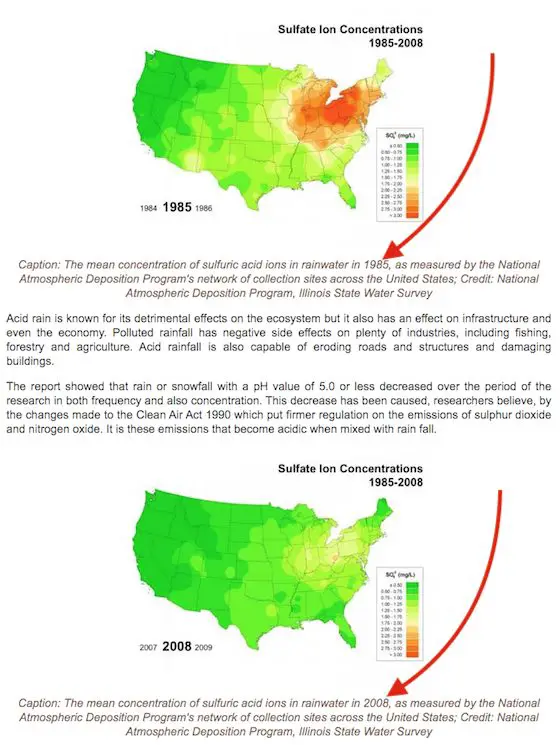
Image and data courtesy of the National Atmospheric Deposition Survey, Illinois State Water Survey - Images and text retrieved using the Fair Use Doctrine from: http://www.earthtimes.org/pollution/acid-rainfall-decrease/1636/
171 Responses to Roof Maxx Review